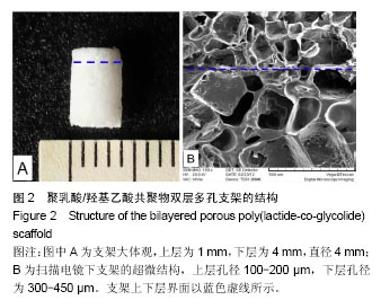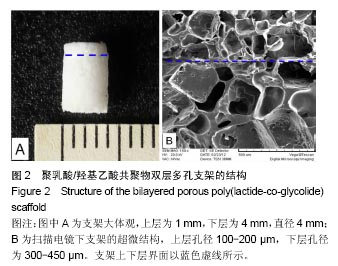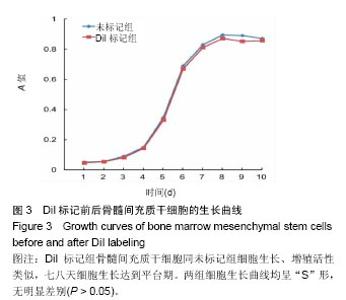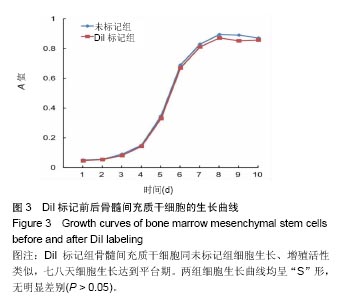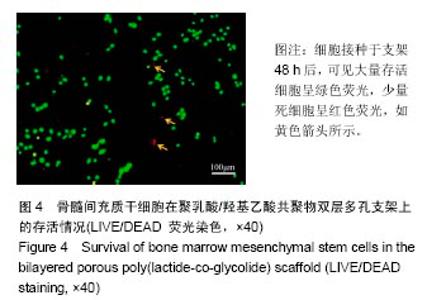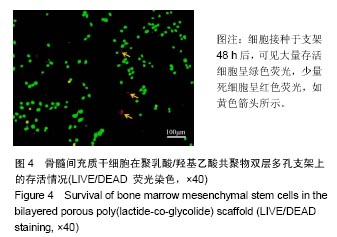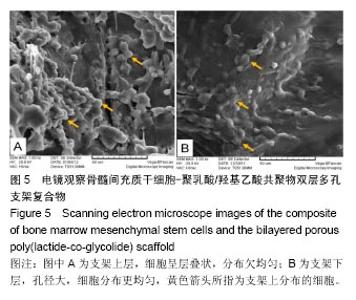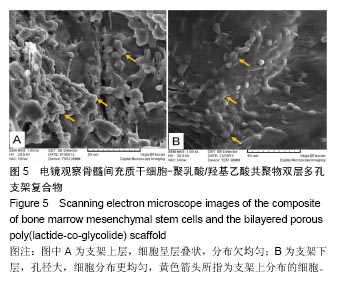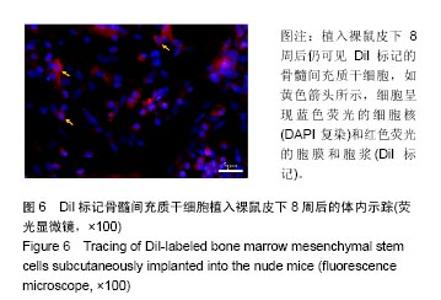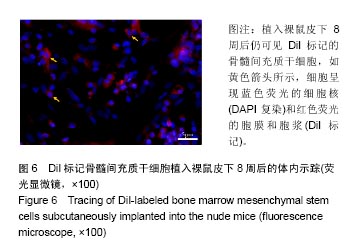Chinese Journal of Tissue Engineering Research ›› 2017, Vol. 21 ›› Issue (34): 5423-5429.doi: 10.3969/j.issn.2095-4344.2017.34.003
Previous Articles Next Articles
Feasibility of constructing a scaffold for osteochondral tissue engineering using poly(lactide-co-glycolide) alone
- 1Department of Orthopedics, First Affiliated Hospital of Nanchang University, Nanchang 330006, Jiangxi Province, China; 2Medical School of Nanchang University, Nanchang 330006, Jiangxi Province, China; 3Department of Polymer Science, Fudan University, Shanghai 200433, China
-
Received:2017-09-19Online:2017-12-08Published:2018-01-04 -
Contact:Yao Hao-qun, M.D., Associate professor, Department of Orthopedics, First Affiliated Hospital of Nanchang University, Nanchang 330006, Jiangxi Province, China -
About author:Duan Ping-guo, M.D., Attending physician, Department of Orthopedics, First Affiliated Hospital of Nanchang University, Nanchang 330006, Jiangxi Province, China -
Supported by:the National Natural Science Foundation of China, No. 81401790; the Natural Science Foundation for the Youth in Jiangxi Province, No. 20171ACB21057; the Natural Science Foundation of Jiangxi Province, No. 20151BAB205053, 20161BAB205235; the Science and Technology Project of Jiangxi Provincial Education Department, No. GJJ160028
CLC Number:
Cite this article
Duan Ping-guo, Guo Run-sheng, Yu Xing-yuan, Pan Zhen, Li Xiao-feng, Li Hu1, Liu Jun, Yao Hao-qun.
share this article
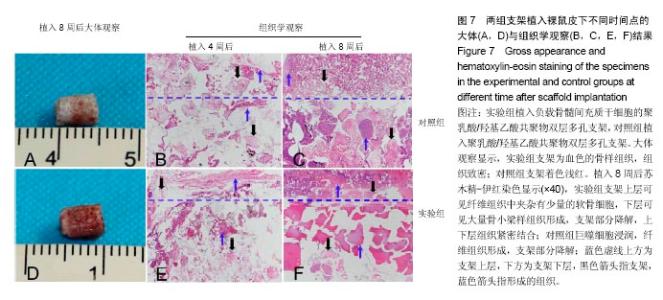
2.4.2 植入物的大体与组织学染色观察结果 裸鼠皮下埋植4,8周后,取出植入物,两组皮下未见明显炎症反应。 实验组:植入4周后,标本大体观未见明显改变,但淡红色中可见原支架白色;苏木精-伊红染色发现支架上层可见少量巨噬细胞浸润,下层可见支架中夹杂有纤维组织、少量的骨小梁样及血管样组织形成,支架上下层结构疏松。植入8周后,标本大体观呈现为血红色的骨样组织,组织致密,硬度增大;苏木精-伊红染色发现支架上层可见纤维组织中夹杂有少量的软骨细胞,下层可见大量骨小梁样组织形成,支架部分降解,上下层组织紧密结合,见图7。 对照组:植入4周后,标本大体观未见明显改变,保留着植入支架的原貌;苏木精-伊红染色显示支架周边可见少量的纤维组织,结构疏松。植入8周后,标本大体观可见支架着色浅红;苏木精-伊红染色显示巨噬细胞浸润,纤维组织形成,支架部分降解,见图7。"
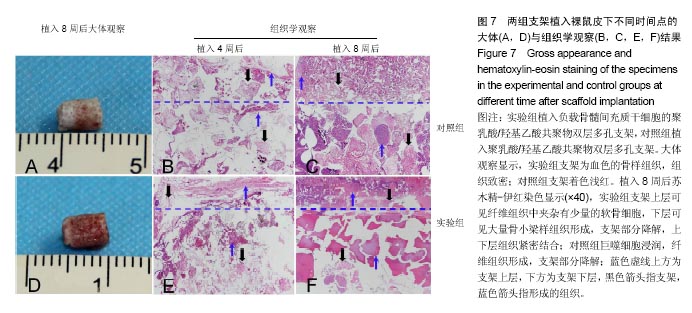
| [1]Causa F,Netti PA,Ambrosio L.A multi-functional scaffold for tissue regeneration: the need to engineer a tissue analogue. Biomaterials.2007;28(34):5093-5099.[2]Frenkel SR,Di Cesare PE.Scaffolds for articular cartilage repair.Ann Biomed Eng.2004;32(1):26-34.[3]Xia W,Liu W,Cui L,et al.Tissue engineering of cartilage with the use of chitosan-gelation complex scaffolds.Biomed MaterRes B Appl Biomater.2004;71(2):373-380.[4]Wang W,Li B,Yang J,et al.The restoration of full-thickness cartilage defects with BMSCs and TGF-beta 1 loaded PLGA/fibrin gel constructs.Biomaterials.2010;31:8964-8973.[5]Fan H,Hu Y,Zhang C,et al.Cartilage regeneration using mesenchymal stem cells and a PLGA-gelatin/ chondroitin/hyaluronate hybrid scaffold. Biomaterials. 2006;27(26):4573-4580.[6]Dai W,Kawazoe N,Lin X,et al.The influence of structural design of PLGA/collagen hybrid scaffolds in cartilage tissue engineering.Biomaterials.2010;31(8):2141-2152.[7]Zhou H,Lawrence JG,Bhaduri SB.Fabrication aspects of PLA-CaP/PLGA-CaP composites for orthopedic applications: a review.Acta Biomater.2012;8(6):1999-2016.[8]Li WJ,Tuan RS. Polymeric scaffolds for cartilage tissue engineering[C].Macromolecular Symposia, 2005;227:65.[9]Tanaka Y,Yamaoka H,Nishizawa S,et al.The optimization of porous polymeric scaffolds for chondrocyte/atelocollagen based tissue-engineered cartilage.Biomaterials. 2010;31(16): 4506-4516.[10]Hollister SJ.Porous scaffold design for tissue engineering.Nat Mater.2005;4:518-524.[11]McMahon LA,O'Brien FJ,Prendergast PJ.Biomechanics and mechanobiology in osteochondral tissues. Regen Med. 2008; 3:743-759.[12]Schek RM,Taboas JM,Segvich SJ,et al.Engineered osteochondral grafts using biphasic composite solid free-form fabricated scaffolds.Tissue Eng.2004;10(9-10):1376-1385.[13]Chen GP,Sato T,Tanaka J,et al.Preparation of a biphasic scaffold for osteochondral tissue engineering.Mater Sci Eng C.2006;26(1):118-123.[14]Ho STB,Hons BE,Hutmacher DW,et al.The evaluation of a biphasic osteochondra implant coupled with an electrospun membrane in a large animal model.Tissue Eng Part A. 2010; 16(4):1123-1141.[15]Nava MM,Draghi L,Giordano C,et al.The effect of scaffold pore size in cartilage tissue engineering. J Appl Biomater Funct Mater.2016;14(3):e223-229. [16]Murphy CM,Haugh MG,O'Brien FJ.The effect of mean pore size on cell attachment, proliferation and migration in collagen-glycosaminoglycan scaffolds for bone tissue engineering.Biomaterials.2010;31(3):461-466.[17]Dai Y,Li X,Wu R,et al.Macrophages of Different Phenotypes Influence the Migration of BMSCs in PLGA Scaffolds with Different Pore Size.Biotechnol J.2017.doi: 10.1002/biot.201700297.[Epub ahead of print][18]Murphy CM,Duffy GP,Schindeler A,et al.Effect of collagen- glycosaminoglycan scaffold pore size on matrix mineralization and cellular behavior in different cell types.J Biomed Mater Res A. 2016;104(1):291-304.[19]Pan Z,Duan P,Liu X,et al.Effect of porosities of bilayered porous scaffolds on spontaneous osteochondral repair in cartilage tissue engineering.Regen Biomater. 2015;2(1): 9-19.[20]Jing D,Wu L,Ding J.Solvent-assisted room-temperature compression molding approach to fabricate porous scaffolds for tissue engineering.Macromol Biosci. 2006;6:747-757.[21]Wu LB,Jing DY,Ding JD.A “room-temperature” injection molding/ particulate leaching approach for fabrication of biodegradable three-dimensional porous scaffolds. Biomaterials.2006;27(2):185-191. [22]Pan Z,Ding J.Poly(lactide-co-glycolide) porous scaffolds for tissue engineering and regenerative medicine.Interface Focus.2012;2(3):366-377. [23]Shao XX,Goh J,Hutmacher DW,et al.Repair of large articular osteochondral defects using hybrid scaffolds and bone marrow-derived mesenchymal stem cells in a rabbit model. Tissue Eng.2006;12(6): 1539-1551.[24]Xue DT,Zheng Q,Zong C,et al.Osteochondral repair using porous poly(lactide-co-glycolide)/nano-hydroxyapatite hybrid scaffolds with undifferentiated mesen- chymal stem cells in a rat model.J Biomed Mater Res A. 2010;94(1): 259-270.[25]段平国,董健.双层支架构建组织工程骨软骨修复关节软骨缺损[J].中华创伤杂志,2012,18(2):189-191.[26]Conoscenti G,Schneider T,Stoelzel K,et al.PLLA scaffolds produced by thermally induced phase separation (TIPS) allow human chondrocyte growth and extracellular matrix formation dependent on pore size.Mater Sci Eng C Mater Biol Appl. 2017;80:449-459.[27]Nuernberger S,Cyran N,Albrecht C,et al.The influence of scaffold architecture on chondrocyte distribution and behavior in matrix-associated chondrocyte transplantation grafts. Biomaterials.2011;32(4):1032-1040.[28]Zeltinger J,Sherwood JK,Graham DA,et al.Effect of pore size and void fraction on cellular adhesion, proliferation, and matrix deposition.Tissue Eng.2001;7(5):557-572.[29]Uematsu K,Hattori K,Ishimoto Y,et al.Cartilage regeneration using mesenchymal stem cells and a three-dimensional poly-lactic- glycolic acid (PLGA) scaffold. Biomaterials. 2005;26(20):4273-4279.[30]Koga H,Muneta T,Ju YJ,et al.Synovial stem cells are regionally specified according to local microenvironments after implantation for cartilage regeneration.Stem Cells. 2007;25(3):689-696.[31]Qu D,Li J,Li Y,et al.Ectopic osteochondral formation of biomimetic porous PVA-n-HA/PA6 bilayered scaffold and BMSCs construct in rabbit.J Biomed Mater Res Part B. 2011;96(1):9-15.[32]周勇,贾兆锋,刘威,等.聚乙烯醇/壳聚糖多孔水凝胶复合骨髓间充质干细胞修复膝关节软骨缺损[J].中国组织工程研究, 2017,21(18):2881-2889. [33]Di Luca A,Szlazak K,Lorenzo-Moldero I,et al.Influencing chondrogenic differentiation of human mesenchymal stromal cells in scaffolds displaying a structural gradient in pore size. Acta Biomater. 2016;36:210-219. |
| [1] | Tan Xinfang, Guo Yanxing, Qin Xiaofei, Zhang Binqing, Zhao Dongliang, Pan Kunkun, Li Yuzhuo, Chen Haoyu. Effect of uniaxial fatigue exercise on patellofemoral cartilage injury in a rabbit [J]. Chinese Journal of Tissue Engineering Research, 2022, 26(在线): 1-6. |
| [2] | Yao Xiaoling, Peng Jiancheng, Xu Yuerong, Yang Zhidong, Zhang Shuncong. Variable-angle zero-notch anterior interbody fusion system in the treatment of cervical spondylotic myelopathy: 30-month follow-up [J]. Chinese Journal of Tissue Engineering Research, 2022, 26(9): 1377-1382. |
| [3] | Wu Cong, Jia Quanzhong, Liu Lun. Relationship between transforming growth factor beta1 expression and chondrocyte migration in adult articular cartilage after fragmentation [J]. Chinese Journal of Tissue Engineering Research, 2022, 26(8): 1167-1172. |
| [4] | Wang Jing, Xiong Shan, Cao Jin, Feng Linwei, Wang Xin. Role and mechanism of interleukin-3 in bone metabolism [J]. Chinese Journal of Tissue Engineering Research, 2022, 26(8): 1260-1265. |
| [5] | Xiao Hao, Liu Jing, Zhou Jun. Research progress of pulsed electromagnetic field in the treatment of postmenopausal osteoporosis [J]. Chinese Journal of Tissue Engineering Research, 2022, 26(8): 1266-1271. |
| [6] | An Weizheng, He Xiao, Ren Shuai, Liu Jianyu. Potential of muscle-derived stem cells in peripheral nerve regeneration [J]. Chinese Journal of Tissue Engineering Research, 2022, 26(7): 1130-1136. |
| [7] | Fan Yiming, Liu Fangyu, Zhang Hongyu, Li Shuai, Wang Yansong. Serial questions about endogenous neural stem cell response in the ependymal zone after spinal cord injury [J]. Chinese Journal of Tissue Engineering Research, 2022, 26(7): 1137-1142. |
| [8] | Wen Dandan, Li Qiang, Shen Caiqi, Ji Zhe, Jin Peisheng. Nocardia rubra cell wall skeleton for extemal use improves the viability of adipogenic mesenchymal stem cells and promotes diabetes wound repair [J]. Chinese Journal of Tissue Engineering Research, 2022, 26(7): 1038-1044. |
| [9] | Zhu Bingbing, Deng Jianghua, Chen Jingjing, Mu Xiaoling. Interleukin-8 receptor enhances the migration and adhesion of umbilical cord mesenchymal stem cells to injured endothelium [J]. Chinese Journal of Tissue Engineering Research, 2022, 26(7): 1045-1050. |
| [10] | Luo Xiaoling, Zhang Li, Yang Maohua, Xu Jie, Xu Xiaomei. Effect of naringenin on osteogenic differentiation of human periodontal ligament stem cells [J]. Chinese Journal of Tissue Engineering Research, 2022, 26(7): 1051-1056. |
| [11] | Wang Xinmin, Liu Fei, Xu Jie, Bai Yuxi, Lü Jian. Core decompression combined with dental pulp stem cells in the treatment of steroid-associated femoral head necrosis in rabbits [J]. Chinese Journal of Tissue Engineering Research, 2022, 26(7): 1074-1079. |
| [12] | Fang Xiaolei, Leng Jun, Zhang Chen, Liu Huimin, Guo Wen. Systematic evaluation of different therapeutic effects of mesenchymal stem cell transplantation in the treatment of ischemic stroke [J]. Chinese Journal of Tissue Engineering Research, 2022, 26(7): 1085-1092. |
| [13] | Guo Jia, Ding Qionghua, Liu Ze, Lü Siyi, Zhou Quancheng, Gao Yuhua, Bai Chunyu. Biological characteristics and immunoregulation of exosomes derived from mesenchymal stem cells [J]. Chinese Journal of Tissue Engineering Research, 2022, 26(7): 1093-1101. |
| [14] | Zhang Jinglin, Leng Min, Zhu Boheng, Wang Hong. Mechanism and application of stem cell-derived exosomes in promoting diabetic wound healing [J]. Chinese Journal of Tissue Engineering Research, 2022, 26(7): 1113-1118. |
| [15] | Huang Chenwei, Fei Yankang, Zhu Mengmei, Li Penghao, Yu Bing. Important role of glutathione in stemness and regulation of stem cells [J]. Chinese Journal of Tissue Engineering Research, 2022, 26(7): 1119-1124. |
| Viewed | ||||||
|
Full text |
|
|||||
|
Abstract |
|
|||||
